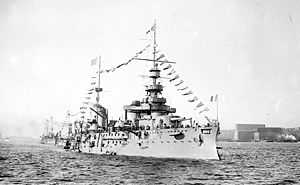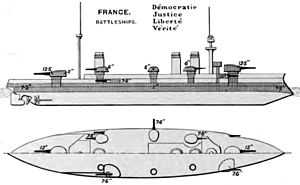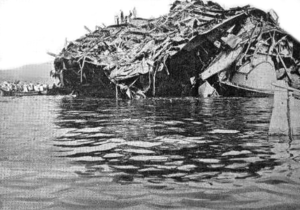French battleship Liberté
 Liberté in harbor | |
| Career (France) | |
|---|---|
| Name: | Liberté |
| Namesake: | Liberty |
| Builder: | Ateliers et Chantiers de la Loire, Saint-Nazaire |
| Laid down: | December 1902 |
| Launched: | 19 April 1905 |
| Completed: | March 1908 |
| Fate: | Destroyed by accidental detonation of her magazines, 25 September 1911 |
| General characteristics | |
| Class and type: | Liberté-class pre-dreadnought battleship |
| Displacement: | 14,860 t (14,630 long tons) |
| Length: | 133.81 m (439 ft 0 in) pp |
| Beam: | 24.26 m (79 ft 7 in) |
| Draft: | 8.41 m (27 ft 7 in) |
| Installed power: | 18,500 shp (13,800 kW) |
| Propulsion: | 3 Vertical triple-expansion steam engines |
| Speed: | 19 knots (35 km/h; 22 mph) |
| Complement: | 739–769 |
| Armament: | 4 × Canon de 305 mm Modèle 1893/96 guns (12.0 in) 10 × Canon de 194 mm Modèle 1902 guns (7.6 in) |
| Armor: | Belt: 280 mm (11.0 in) Turrets: 350 mm (13.8 in) Conning tower: 305 mm (12.0 in) |
Liberté was a pre-dreadnought battleship of the French Navy, and the lead ship of her class. She was laid down in November 1902, launched in April 1905, and completed in March 1908, over a year after the revolutionary British battleship HMS Dreadnought made ships like Liberté obsolete. After her commissioning, Liberté was assigned to the Mediterranean Fleet. She served for only three and a half years; while moored in Toulon in September 1911, an explosion of badly degraded propellant charges detonated the forward ammunition magazines. Some 250 officers and men were killed, and the ship was totally destroyed. The wreck remained in the harbor until 1925, when it was raised and broken up for scrap.
Design

Liberté was laid down at the Ateliers et Chantiers de la Loire shipyard in November 1902, launched on 19 April 1905, and completed in March 1908.[1] This was over a year after the revolutionary British battleship HMS Dreadnought, which rendered the pre-dreadnoughts like Liberté outdated before they were completed.[2] The ship was 133.81 meters (439 ft 0 in) long between perpendiculars and had a beam of 24.26 m (79 ft 7 in) and a full-load draft of 8.41 m (27 ft 7 in). She displaced up to 14,860 metric tons (14,630 long tons; 16,380 short tons) at full load. She had a crew of between 739 and 769 officers and enlisted men. She was powered by three vertical triple-expansion steam engines with twenty-two Belleville boilers. They were rated at 18,500 indicated horsepower (13,800 kW) and provided a top speed of 19 knots (35 km/h; 22 mph). Coal storage amounted to 1,800 t (1,800 long tons; 2,000 short tons).[1]
Liberté 's main battery consisted of four Canon de 305 mm Modèle 1893/96 guns mounted in two twin gun turrets, one forward and one aft. The secondary battery consisted of ten Canon de 194 mm Modèle 1902 guns; six were mounted in single turrets, and four in casemates in the hull. She also carried thirteen 9-pounder guns and ten 3-pounders. The ship was also armed with two 450 mm (17.7 in) torpedo tubes submerged in the hull. The ship's main belt was 280 mm (11.0 in) thick and the main battery was protected by up to 350 mm (13.8 in) of armor. The conning tower had 305 mm (12.0 in) thick sides.[1]
Service history

After commissioning, Liberté was assigned to the Active Squadron of the French Mediterranean Fleet.[3] In September 1909, Liberté, Justice, and Vérité visited the United States for the Hudson-Fulton Celebration. The three battleships, commanded by Admiral Jules le Pord, were the first foreign contingent to arrive.[4]
On 25 September 1911, as Liberté was moored in Toulon harbor, an accidental explosion in one of her forward ammunition magazines for the secondary guns destroyed the ship.[1] After the initial explosion of propellant charges, the ship's commander tried to organize damage control teams at the stern. He sent a party forward to flood the magazines to prevent an explosion in the main magazines, but the flooding valves were located under the magazines, and the path was blocked by fires and smoke. After two failed attempts to reach the valves, the men returned to the captain, who ordered them to try again; they were killed when the main magazines exploded shortly thereafter.[5] The explosion hurled a 37-metric-ton (36-long-ton; 41-short-ton) chunk of armor plate from the ship into the battleship République moored some 210 m (690 ft) away, which caused significant damage.[6]
The French Navy had suffered a series of fatal accidents in Toulon, beginning with an explosion aboard a torpedo boat in February 1907, in which nine men were killed. The following month, the battleship Iéna blew up, killing 107 men. An explosion aboard a gunnery training ship killed six in August 1908, and an explosion on a cruiser killed 13. Six more men were killed aboard the cruiser Gloire a year later, on 10 September 1911. The explosion aboard Liberté killed some 250 officers and men.[6] The culprit was unstable Poudre B, a nitrocellulose-based propellant that was also responsible for the destruction of Iéna,[7] and possibly the other explosions as well.[6] The wreck remained in Toulon until 1925, when she was raised and broken up for scrap.[1]
Footnotes
| Wikimedia Commons has media related to Liberté. |
References
- Brassey, Thomas A., ed. (1908). Brassey's Naval Annual (Portsmouth, UK: J. Griffin & Co.). Missing or empty
|title=(help) - Chiles, James R. (2011). Inviting Disaster: Lessons From the Edge of Technology. New York, NY: Harper Business. ISBN 0-06-662082-1.
- Gardiner, Robert, ed. (1979). Conway's All the World's Fighting Ships 1860–1905. Greenwich, UK: Conway Maritime Press. ISBN 978-0-8317-0302-8.
- Gardiner, Robert; Gray, Randal, eds. (1984). Conway's All the World's Fighting Ships: 1906–1922. Annapolis, MD: Naval Institute Press. ISBN 978-0-87021-907-8.
- Levine, Edward F.; Panetta, Roger (2009). Hudson–Fulton Celebration of 1909. Charleston, SC: Arcadia Pub. ISBN 978-0-7385-6281-0.
- Oxlade, Chris (2011). Gunpowder. Chicago, Il: Heinemann Library. ISBN 978-1-4329-5458-1.
| ||||||||||||||